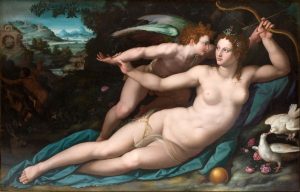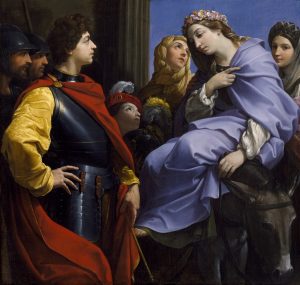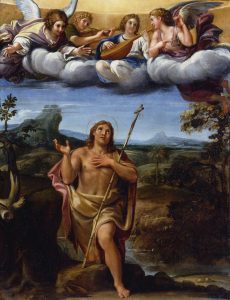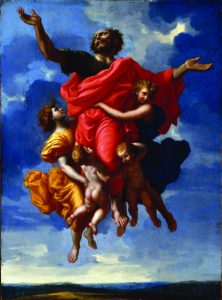October 26, 2018 through January 27, 2019
In celebration of the city of New Orleans’ Tricentennial in 2018, the New Orleans Museum of Art (NOMA) will present The Orléans Collection, an exhibition of selections from the magnificent collection of the city’s namesake, Philippe II, Duke of Orléans (1674-1723). Universally praised during his lifetime, the exceptional collection was comprised of some of the most important works in the history of art. On view from October 26, 2018 through January 27, 2019, The Orléans Collection will bring together, for the first time, a selection of masterpieces from institutions such as the National Gallery of London, the J. Paul Getty Museum, and the National Gallery of Scotland to tell the story of the collection’s formation, its reputation, and its impact in early 18th century Paris.
“Renowned at the time of the founding of the City of New Orleans, The Orléans Collection celebrates the artistic sensibilities of Philippe II,” said Susan Taylor, the Montine McDaniel Freeman Director of NOMA. “His legacy is his patronage of the arts: architecture, painting, music, dance and theatre. As an institution that is committed to celebrating all of the arts, it is fitting that NOMA takes on this project during New Orleans’ Tricentennial.”
The Orléans Collection situates Philippe II as the preeminent collector of his time. The astounding number of paintings recorded at the time of the Duke’s death—772—demonstrate the scope of his collection, which remained in his family for two generations until its sale in London in the 1790s during the French Revolution. Its dispersal represents a watershed event in the history of collecting, and contributed to the formation of Europe’s first public museums, among them, the National Gallery of London.
“A unique strength of our subject is the quality and breadth of Philippe II’s collection itself, which will offer visitors an overview of European art, from Venice and Rome to The Netherlands and France,” said Vanessa Schmid, NOMA’s Senior Research Curator for European Art.
Featured Themes
The Orléans Collection will explore aspects of Philippe II’s collection through four guiding themes: the Duke’s residence, the Palais Royal, and its grand redecoration as a center for the arts and exchange in Paris; the diplomatic and personal display of the collection in public and private spaces; the Duke of Orléans’ personal taste and psychology as a collector, and the fame and impact the collection had for visitors, contemporary artists, and collectors in Paris.
Upon the death of Louis XIV in 1715, Philippe II served as the regent of France until the young heir Louis XV came of age. After two generations of court life focused at Versailles, Philippe II’s eight-year regency represented an important shift of French social and cultural life back to Paris around the newly flourishing neighborhood on the Right Bank surrounding the Duke’s Palais-Royal.
The Duke had a remarkably developed sense of style, which is evident through his favorite paintings, and works by his court painter, Antoine Coypel, who is featured in the exhibition. He was most passionate about Renaissance Florentine and Venetian art, which hung in his grand gallery. He was also France’s first great collector of Dutch and Flemish art, which he displayed in the intimate setting of his private apartments. The installation will evoke the more coveted spaces of the Palais Royal, where many of the Duke’s notorious parties took place.
Philippe II cultivated a cosmopolitan circle and worked with agents and friends to acquire paintings. He sought to build a princely collection of international reputation, and visitors to the Palace wrote with awe of the sheer number of pictures and their sumptuous display. In 1721, the Duke’s important purchase of the collection of Queen Christina of Sweden brought over 100 masterpieces to Paris and was announced in the first Parisian art review. The collection included treasures from the Habsburg collections commissioned by Philip II of Spain, the Holy Roman Emperor Charles V, and Rudolf II in Vienna. He purchased many other paintings, which came from European monarchs, played an important role in projecting a public image of nobility.
The final theme considers the impact of Philippe II’s collection in Paris for collectors and artists. Visitors and early guidebooks attest to the public orientation of the collection at the Palais Royal and the unique status of this princely collection as neither truly of the crown nor truly private. Many well-known French artists like Boucher and Natoire studied the collection and reinterpreted its famous paintings to the modern style.
Exhibition Catalogue
Offering opportunities for new scholarship, NOMA’s exhibition is the first time this subject has been undertaken. The exhibition will be accompanied by a full color 300-page scholarly catalogue, by project director Vanessa Schmid, NOMA’s Senior Research Curator for European Art. The catalogue will present new research and serve as a lasting resource for scholars and the general public alike. Contributors include leading scholars in the fields represented in the collection. Essay and discussion topics include: Philippe d’Orléans: Absolute Regent by historian Alexandre Duplet; Philippe II’s Collection by Françoise Madrus, The Louvre Museum; Antoine Coypel and the Regent by Nicole Garnier, Musée Condé; The Le Brun of Architecture: Gilles-Marie Oppenord at the Palais-Royal by Jean-François Bédard, Syracuse University; Venetian Art at the Palais Royal by Xavier Salomon, The Frick Collection; The Emergence of the Bolognese School by Rachel McGarry, Minneapolis Institute of Art; The Palais-Royal and Contemporary Art in Paris by Kelsey Brosnan, New Orleans Museum of Art; and The Orléans Phenomenon in Great Britain and an appendix tracing the Duke’s paintings to their current locations, both by J. Armstrong-Totten, formerly of the Getty’s Project for the Study of Provenance.







